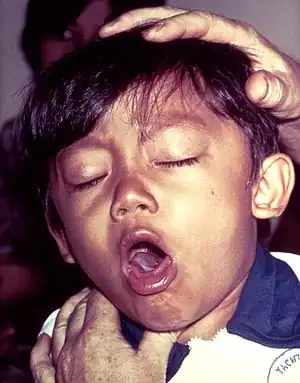Postinfectious cough
| Postinfectious cough | |
|---|---|
| Other names: Post viral cough | |
 | |
| Boy coughing due to whooping cough due to pertussis. | |
| Specialty | Family medicine |
| Symptoms | Prolonged cough[1] |
| Complications | Trouble sleeping, stress incontinence[2] |
| Duration | 3 to 8 weeks[1] |
| Causes | Respiratory tract infection[3] |
| Diagnostic method | Based on symptoms after ruling out other causes[4] |
| Differential diagnosis | Asthma, GERD, COPD, pneumonia, tuberculosis[4][3] |
| Prevention | Vaccination[4] |
| Treatment | Time, inhaled corticosteroids, ipratropium/salbutamol[1] |
| Frequency | Up to 25% of respiratory infections[4] |
Postinfectious cough (PIC) is a cough that lasts 3 to 8 weeks after a respiratory tract infection, such as a common cold or flu.[1] The cough generally does not result in the production of mucus.[5] After pertussis the cough can be particularly severe, with vomiting or a whoop after an episode.[4] Complications may include trouble sleeping or stress incontinence.[2]
The underlying mechanism may involve a number of factors including heightened sensitivity of the respiratory tract, increased mucus production, postnasal drip, and reflux.[4] Diagnosis is based on symptoms after ruling out other possible causes.[4] It is classified as subacute.[4]
While most people get better after a further 3 weeks, inhaled corticosteroids or ipratropium/salbutamol may help.[1][3] A steroid nose spray may be used in those in whom postnasal drip may be contributing.[3] The use of antibiotics is generally not indicated.[4] Other options may include dextromethorphan.[4]
Postinfectious cough occurs in up to 25% of respiratory infection and up to half of cases of pertussis.[4] In COVID-19 cough lasts for more than 4 or 5 weeks in about 5 to 10% of people.[6] Children are more commonly affected.[4] It occurs more commonly during winter.[4]
Signs and sympoms
Symptoms is a cough that lasts 3 to 8 weeks after a respiratory tract infection, such as a common cold or flu.[1] Worrisome signs include coughing out blood, significant shortness of breath, ongoing fever or chills, and abnormal vital signs.[3]
Cause
One possible cause is that the receptors that are responsible for stimulating the cough during the respiratory tract infection are up-regulated by respiratory tract infection and continue to stimulate even after the virus has disappeared.[7]
Diagnosis
Diagnosis is based on symptoms after ruling out other possible causes.[4] It may be supported by a normal chest X-ray, but if there are no worrisome symptoms this is not needed.[4][8]
Differential diagnosis
Other conditions that may produce similar symptoms include asthma, GERD, COPD, pneumonia, tuberculosis.[4][3] ACE inhibitors may also result in a prolonged cough.[9]
Treatment
While most people get better after a further 3 weeks, inhaled corticosteroids or ipratropium/salbutamol may help.[1]
See also
References
- 1 2 3 4 5 6 7 Ton, Joey (11 December 2022). "#329 Coughing up the evidence: Bronchodilators or inhaled steroids for post-infectious cough". CFPCLearn. Archived from the original on 28 March 2023. Retrieved 14 June 2023.
- 1 2 Sydney, Elana; Weinstein, Eleanor; Rucker, Lisa M. (1 January 2023). Handbook of Outpatient Medicine. Springer Nature. p. 241. ISBN 978-3-031-15353-2. Archived from the original on 3 July 2023. Retrieved 2 July 2023.
- 1 2 3 4 5 6 Moe, Samantha S.; Braschi, Emélie; Allan, G. Michael (March 2023). "Bronchodilators or inhaled corticosteroids for postinfectious cough". Canadian Family Physician. 69 (3): 180–180. doi:10.46747/cfp.6903180.
- 1 2 3 4 5 6 7 8 9 10 11 12 13 14 15 16 Braman, Sidney S. (January 2006). "Postinfectious Cough". Chest. 129 (1): 138S–146S. doi:10.1378/chest.129.1_suppl.138S. PMID 16428703.
- ↑ Feteih, Abeer; Fein, Michael; Tardio, Natacha (27 December 2021). The Manual of Allergy and Clinical Immunology. CRC Press. p. 60. ISBN 978-1-000-47935-5. Archived from the original on 3 July 2023. Retrieved 2 July 2023.
- ↑ Song, Woo-Jung; Hui, Christopher K M; Hull, James H; Birring, Surinder S; McGarvey, Lorcan; Mazzone, Stuart B; Chung, Kian Fan (May 2021). "Confronting COVID-19-associated cough and the post-COVID syndrome: role of viral neurotropism, neuroinflammation, and neuroimmune responses". The Lancet Respiratory Medicine. 9 (5): 533–544. doi:10.1016/S2213-2600(21)00125-9.
- ↑ "International Society for the Study of Cough". Archived from the original on 2017-05-09. Retrieved 2023-03-15.
- ↑ Kellerman, Rick D.; Rakel, David P. (2 November 2022). Conn's Current Therapy 2023: Conn's Current Therapy 2023 - E-Book. Elsevier Health Sciences. p. PT49. ISBN 978-0-443-10562-3. Archived from the original on 3 July 2023. Retrieved 2 July 2023.
- ↑ Broaddus, V. Courtney; Ernst, Joel D.; Jr, Talmadge E. King; Lazarus, Stephen C.; Sarmiento, Kathleen; Schnapp, Lynn; Stapleton, Renee D.; Gotway, Michael B. (28 May 2021). Murray & Nadel's Textbook of Respiratory Medicine: Murray & Nadel's Textbook of Respiratory Medicine E-Book. Elsevier Health Sciences. p. 517. ISBN 978-0-323-65588-0. Archived from the original on 3 July 2023. Retrieved 2 July 2023.